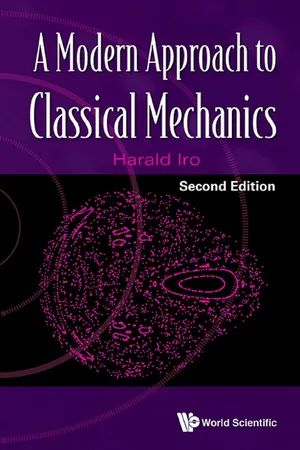Physics
Motion in Two Dimensions
Motion in two dimensions refers to the movement of an object in both the x and y directions simultaneously. This type of motion can be described using vectors, which include both magnitude and direction. Understanding motion in two dimensions is essential for analyzing the trajectory of projectiles, the motion of objects in circular paths, and other complex motion scenarios.
Written by Perlego with AI-assistance
Related key terms
6 Key excerpts on "Motion in Two Dimensions"
- eBook - ePub
- Hiqmet Kamberaj(Author)
- 2021(Publication Date)
- De Gruyter(Publisher)
4 Two- and three-dimensional motionIn this chapter, we will discuss the kinematics of a particle moving in two and three dimensions. Utilizing two- and three-dimensional motion, we will be able to examine a variety of movements, starting with the motion of satellites in orbit to the flow of electrons in a uniform electric field. We will begin studying in more detail the vector nature of displacement, velocity, and acceleration. Similar to one-dimensional motion, we will also derive the kinematic equations for three-dimensional motion from these three quantities’ fundamental definitions. Then the projectile motion and uniform circular motion will be described in detail as particular cases of the movements in two dimensions.4.1 The displacement, velocity, and acceleration vectors
When we discussed the one-dimensional motion (see Chapter 3 ), we mentioned that the movement of an object along a straight line is thoroughly described in terms of its position as a function of time,x ( t ). For the two-dimensional motion, we will extend this idea to the movement in thex yplane.As a start, we describe a particle’s position by the position vector r pointing from the origin of some coordinate system to the particle located in thex yplane, as shown in Fig. 4.1 . At timet ithe particle is at point P, and at some later timet fit is at the position Q. The path from P to Q generally is not a straight line. As the particle moves from P to Q in the time intervalΔ t =, its position vector changes fromt f−t ir itor f.Definition 4.1 (Displacement vector).
The displacement is a vector, and the displacement of the particle is the difference between its final position and its initial position. We now formally define the displacement vector for the particle as the difference between its final position vector and its initial position vector:(4.1)Δ r =r f−r i.The direction ofΔ ris indicated in Fig. 4.1 from P to Q. Note that the magnitude ofΔ r - eBook - ePub
- Michael M. Mansfield, Colm O'Sullivan(Authors)
- 2020(Publication Date)
- Wiley(Publisher)
4 Motion in two and three dimensionsAIMS
- to show how, in two and three dimensions, physical quantities can be represented by mathematical entities called vectors
- to rewrite the laws of dynamics in vector form
- to study how the laws of dynamics may be applied to bodies which are constrained to move on specific paths in two and three dimensions
- to describe how the effects of friction may be included in the analysis of dynamical problems
- to study the motion of bodies which are moving on circular paths
4.1 Vector physical quantities
The material universe is a three‐dimensional world. In our investigation of the laws of motion in Chapter 3 , however, we considered only one‐dimensional motion, that is situations in which a body moves on a straight line and in which all forces applied to the body are directed along this line of motion. If a force is applied to a body in a direction other than the direction of motion the body will no longer continue to move along this line. In general, the body will travel on some path in three‐dimensional space, the detail of the trajectory depending on the magnitude and direction of the applied force at every instant. Equation (3.3) as it stands is not sufficiently general to deal with such situations, for example the motion of a pendulum bob (Figure 4.1 ) or the motion of a planet around the Sun (Figure 4.2 ). Newton's second law needs to be generalised from the simple one‐dimensional form discussed in Chapter 3 .A pendulum comprising a mass attached to the end of a string; the mass can move on a path such that the distance from the fixed end of the string remains constant.Figure 4.1A similar problem arises if two or more forces act on a body simultaneously, for example when a number of tugs are manoeuvring a large ship (Figure 4.3 - eBook - ePub
- A. D. Johnson(Author)
- 2017(Publication Date)
- CRC Press(Publisher)
Motion of bodies 22.1 Aims
- To introduce the concepts of linear and angular motion.
- To explain the relationships between displacement, velocity and acceleration.
- To explain the relationship between absolute and relative velocities.
- To define the equations used to analyse linear and angular motion.
- To introduce an approach by which linear and angular motion problems can be analysed.
- To explain related topics such as ‘falling bodies’, ‘trajectories’ and vector methods.
2.2 Introduction to Motion
When traffic lights turn to green a car will move away with increasing velocity. The car will cover a distance in a particular direction and will possess a particular velocity at any instant. During this process the car possesses the three basic constituents of motion, namely: displacement, velocity and acceleration. It should be noted that since the car runs on wheels, these will also be in motion and therefore possess displacement, velocity and acceleration. However, the car moves in a linear direction, while the wheels move in an angular direction.2.2.1 Displacement
If a man walks 10 km, there is an indication of the distance between the start position and the final position, but there is no indication of the direction. The 10 km is merely the distance covered and, as such, is a scalar quantity, i.e. possessing magnitude only. Displacement, however, implies a change in position or movement over a distance and gives the position and direction from the start point. Thus displacement is a vector quantity possessing both magnitude and direction.Fig. 2.1 Displacement diagram.Figure 2.1 gives an example of a man who walks 3 km east then 4 km north. He has actually walked a distance of 7 km but has been displaced from his start point by only 5 km.2.2.2 Velocity
Velocity is the value of displacement measured over a period of time. It is the rate over which a distance/displacement is traversed. The magnitude of velocity is often expressed in convenient units such as kilometres per hour or miles per hour; however, these should be regarded as observation and comparison units. For analysis purposes velocity is better expressed in SI units of m/s. - eBook - ePub
- Harald Iro(Author)
- 2015(Publication Date)
- WSPC(Publisher)
3One-dimensional motion of a particle
The simplest system consists of a single particle whose motion only has one degree of freedom. In the following, we investigate the constants of the motion and the conserved quantities for Newton’s equation in one dimension. Since the representation in phase space here is two-dimensional, the particle’s motion in phase space can be visualized graphically.3.1 Examples of one-dimensional motion
Figure 3.1: The inclined track.i) The inclined track: A particle of mass m slides without friction on a track inclined at angle α to the direction of the gravitational force F = mg. Since forces obey vector addition (see Page 17), the force of gravity can be split into components parallel and perpendicular to the track1 :where (see Fig. 3.1 )Motion along the track is influenced only by F|| ; the perpendicular component F is exactly counterbalanced by the track2 (see Fig. 3.1 ). Let s be the distance along the track (with respect to some initial point s0 = 0). The momentum of the particle is p = m . Hence, the equation of motion isFigure 3.2: The plane pendulum.Figure 3.3: An oscillating mass.ii) The plane mathematical pendulum: A particle of mass m is attached to the end of a massless bar of length l that can swing freely about a fixed point. The particle is pushed such that its motion always remains in the plane (i.e. the initial velocity vector lies in the plane containing the bar and gravitational force vector). Since lϕ is the arclength, where ϕ is the angle between the bar and the vertical, the equation of motion reads (see also Section 3.3.2 below):iii) The harmonic oscillator: A particle of mass m is confined to move along the x-axis. It is attached to a spring, with equilibrium position xequ. Assume that the spring obeys Hooke’s Law, |F| ∝ |x − xequ|, meaning that the force is harmonic, i.e. it is given by F = −k(x − xequ). If xequis chosen as the origin, i.e. xequ - eBook - ePub
Doing Physics with Scientific Notebook
A Problem Solving Approach
- Joseph Gallant(Author)
- 2012(Publication Date)
- Wiley(Publisher)
Chapter 2One-Dimensional Kinematics
We start Doing Physics with SNB in the branch of physics known as Classical Mechanics. Our study of Classical Mechanics begins with one-dimensional kinematics, the description of motion in a straight line. This includes horizontal motion to the right or left and vertical motion straight up or down. This description will tell us where an object is, where it is going, and how much time it took to get there.Constant Acceleration
Studying motion with a constant acceleration is a good place to start. We can describe this motion completely without using calculus. Let’s start with some definitions and important distinctions, and then we’ll solve some one-dimensional problems.Displacement and Position
To describe an object’s motion, we need to establish a coordinate system so we can specify location. For 1-dimensional motion the coordinate system is just the x-axis with the origin at x = 0 and positive values to the right. The object’s position, specified by its x-coordinate, tells us how far from the origin it is and in which direction.The displacement is the object’s change in position.(2.1)This difference between the object’s final and initial position tells us how far from its original position it ends. A positive displacement means the object ends to the right of x0 and a negative displacement means the object ends to the left of x0 . For a round trip, the initial and final positions are equal and the displacement is zero. The SI unit for both position and displacement is the meter (m).Note The use of the upper case Greek letter delta (“Δ”) to mean “change in” is standard mathematical notation, but it has no special significance in SNB. In a calculation, SNB interprets the expression Δf as Δ x f, the product of two variables.Even though they have the same unit, displacement and distance are different. Suppose you start 2 meters from the origin, walk 9 meters to the right, turn around and walk 5 meters back toward the origin. Your initial position was x0 = 2 m and your final position is x = 6m, so your displacement is Δx - eBook - ePub
- William Bolton(Author)
- 2012(Publication Date)
- Routledge(Publisher)
4 Linear and angular motion 4.1 Introduction This chapter is concerned with the behaviour of dynamic mechanical systems when there is uniform acceleration. The terms and basic equations associated with linear motion with uniform acceleration and angular motion with uniform angular acceleration, Newton’s laws of motion, moment of inertia and the effects of friction are revised and applied to the solution of mechanical system problems. The terms scalar quantity and vector quantity are used in this chapter, so as a point of revision: Scalar quantities are those that only need to have their size to be given in order for their effects to be determined, e.g. mass. Vector quantities are those that need to have both their size and direction to be given in order for their effects to be determined, e.g. force where we need to know the direction as well as the size to determine its effect. 4.2 Linear motion The following are basic terms used in the description of linear motion, i.e. motion that occurs in a straight line path rather than rotation which we will consider later in this chapter: 1 Distance and displacement The term distance tends to be used for distances measured along the path of an object, whatever form the path takes; the term displacement, however, tends to be used for the distance travelled in a particular straight line direction (Figure 4.1). For example, if an object moves in a circular path the distance travelled is the circumference of the path whereas the displacement might be zero if it ends up at the same point it started from
Index pages curate the most relevant extracts from our library of academic textbooks. They’ve been created using an in-house natural language model (NLM), each adding context and meaning to key research topics.





